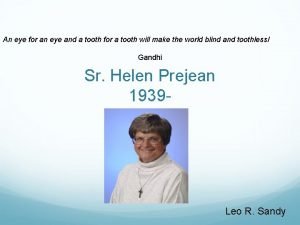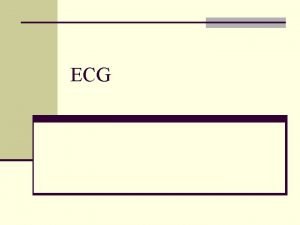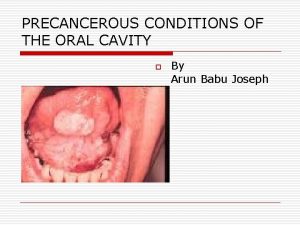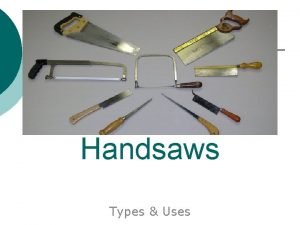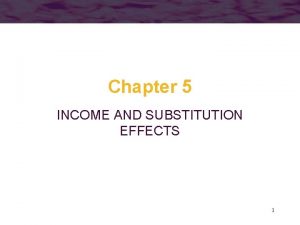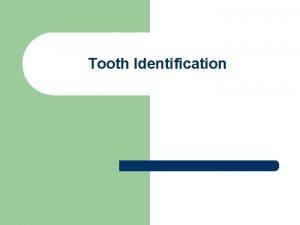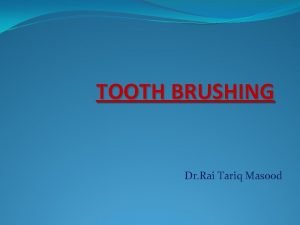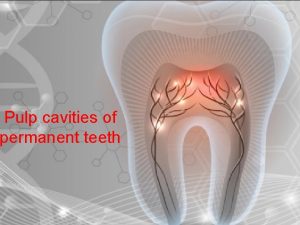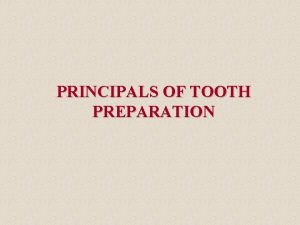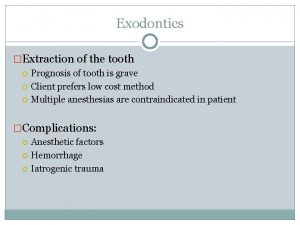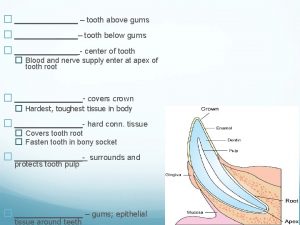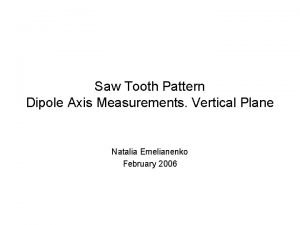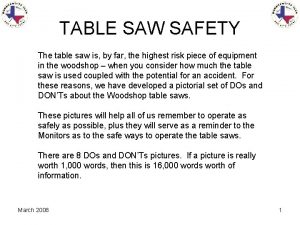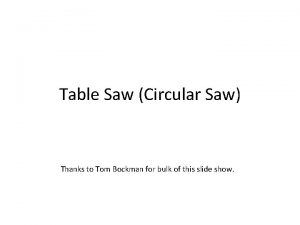SAW TOOTH The saw tooth effect in the





































- Slides: 37

SAW TOOTH The saw tooth effect in the geometry measurements, possible remedies by data treatment Elena. Wildner and Natalia Emelianenko AT/MAS Saw Tooth and remedies - Elena Wildner 1

Outline I. Description of problem II. Reasons for the effect III. Evaluation criteria IV. Results of the evaluation V. Conclusion Saw Tooth and remedies - Elena Wildner 2

I. Description of the problem 1 The analysis is made for the Dipole where the effect is significant Magnet 2248 Result from measurement after cold test. Questions: Why do the spools “move” by up to 0. 5 mm from industry measurement to CERN measurement? Why are measurements varying up to 1 mm along the axis? Saw Tooth and remedies - Elena Wildner The two measurements from both sides of the magnet separated: Red: connection side Blue: lyra side 3

I. Description of the problem 2 The idea: Consider the point close to the Tracker more correct than points far from the Tracker. By superposing the curves while keeping fix the points close to the tracker, we can reduce the saw tooth considerably and retrieve the shape The questions: What do the effect(s) come from ? Where is the new GA ? Is the deviation linear ? Is the procedure applicable to different kinds of errors? Where exactly are the “fix points” ? What are the criteria for a good data treatment? What best fits to apply for the measurement curves to be rotated? Etc…… Saw Tooth and remedies - Elena Wildner 4

I. Description of the problem 2 D. Missiaen, M, Dupont, P. Winkes: The Laser Tracker: a major tool for the metrology of the LHC, IWAA 2004, CERN, Geneva, 4 -7 October 2004 Saw Tooth and remedies - Elena Wildner 5

I. Description of the problem 2 E. Ainardi, L. Bottura, and N. Smirnov, “Light beam deflection through a 10 m long dipole model”, CERN LHC-MTA, Tech. Rep. May 1999. N. Smirnov et al. “The methods of the LHC Magnets’ Magnetic Axis Location Measurement”. IWAA 1999. P. Schnizer et al. “Experience from measuring the LHC Quadrupole axes”. IWAA 2004. Interesting reading! What we use for our presentation are the following facts from these articles: 1. 2. 3. 4. We may have a longitudinal temperature difference along the magnet This may cause a convection cell at the ends of the magnet at ~ 0. 2 m from the cold bore ends The convection cells deflect the light beam Act only in the vertical plane lens error tracker 0. 2 Saw Tooth and remedies - Elena Wildner 6

I. Description of the problem 2 To sum up: Bundle (best fit on network points of several measurements to have the measurements in the same reference system): 0. 08 mm rms at any position (3 s ~ 0. 2 mm). Calibration centring error: 0. 07 mm. This is not visible in the vertical plane and considered = 0 for the treatment. Leica errors with distance: 5 ppm (rms) which translates to 0. 005*3 mm for close points and 0. 075*3 mm for far points. This we take into account. The temperature effect may contribute to more than 0. 5 mm for quadrupole (shorter than dipole). For the present production conditions this seems to give a considerable contribution, that could be corrected. For this effect we have a bias of the magnet positioning (magnets too low). To have an idea of the errors for one measurement from one side we have taken the xxx? ? ? (in this way we try to make sure that shape changes do not contribute) Saw Tooth and remedies - Elena Wildner 7

I. Description of the problem 2 1. Spool piece position calculation (industry data), evaluation of effect of saw tooth on positioning (CERN data) 2. 3. 2. Aperture: The degradation in the vertical plane of the so called geometry classes is very sensitive. If the tolerances are tightened by only 0. 15 mm all golden magnets degrade to silver!!! Where is really the magnet? Are the shifts in the correct direction? All degraded if 0. 1 mm shift in GA in firm 2!!! fraction v h v [0. 01 mm] h [0. 01 mm] 0. 01 mm Saw Tooth and remedies - Elena Wildner 8

I. Description of the problem 2 Dipoles of firm 1 tested during last 5 months of 2005, aperture 1 Saw Tooth and remedies - Elena Wildner 9

I. Description of the problem 2 Saw Tooth Height The “Y-mate” point should be calculated for each point measured from another side by means of interpolation difference Saw Tooth and remedies - Elena Wildner 10

I. Description of the problem 2 Saw Tooth Height – Average To calculate the average saw tooth height the area between the curves should be divided by the length on which the both points are known at each yi — + If the connection curve lies below the lyre one, the area is negative. We can sum up signed or absolute values. Since the points are evenly spread this differs from simple average by max 0. 02 mm Saw Tooth and remedies - Elena Wildner 11

I. Description of the problem 2 Absolute Average Tooth Height over Time “With sign” Saw Tooth and remedies - Elena Wildner 12

I. Description of the problem 2 Average Absolute Height: Firms Step ITP 15 Saw Tooth and remedies - Elena Wildner 13

I. Description of the problem 2 Average Absolute Height: Firms Step ITP 20 -GEO Saw Tooth and remedies - Elena Wildner 14

I. Description of the problem 2 Difference is not always Linear: Example 1 For many magnets the difference in the middle is constant or decreasing when the global slope is positive. Example: 3428 A 1 WP 08 -FID Diff > 0 Saw Tooth and remedies - Elena Wildner 15

I. Description of the problem 2 Difference is not Linear: Example 3 Example: 1045 A 2 Step WP 08 -FID Unusual pattern Saw Tooth and remedies - Elena Wildner 16

I. Description of the problem 2 Horizontal Plane Saw tooth criterion: Whole production statistics is very close to the simulation results* (G. Gubello et al. 2004) Here p - slope, q – shift, h – tooth STEP Height* average Height std Slope avg Slope std Shift avg Shift std ITP 15 0. 083 0. 050 -9. 51 E-08 7. 04 E-06 0. 016 0. 110 ITP 20 -GEO 0. 085 0. 048 9. 33 E-07 8. 40 E-06 0. 011 0. 112 WP 08 -FID 0. 091 0. 053 3. 17 E-06 6. 91 E-06 -0. 016 0. 112 * Vertical plane similar from recent modeling by Marco Saw Tooth and remedies - Elena Wildner 17

I. Description of the problem 2 The Bundle Arbitrary reference systems, chosen here to be the GA of one side measurement Saw Tooth and remedies - Elena Wildner 18

I. Description of the problem 2 The Bundle Saw tooth criterion: Saw Tooth and remedies - Elena Wildner 19

I. Description of the problem 2 The Bundle Saw tooth criterion: Saw Tooth and remedies - Elena Wildner 20

I. Description of the problem 2 The Bundle In industry: Where is mounted the spool piece? The best possible guess of the tube position is the “mean” of the point. GA is the best possible choice. We have to estimate the error on the spool piece position by the difference in the GA of the two measurements from the two sides. GA on which the spool is mounted and measured, itp 15 bis. Itp 20 just intermediate (for corrector) “Best fit” Saw Tooth and remedies - Elena Wildner At CERN: the spool piece is measured via an external point (end cover) so no problem with saw tooth. The effect is small for the aperture, impact has been evaluated by simulations by Marco la China. 21

I. Description of the problem 2 z 2 D !!! Linear interpolation from “knee” at 0. 2 cm, from ends y Reference line for the correction 0. 2 m Convection cell position Measurement from Connection Side Crossover straight line from best fit and the 0. 2 m boundary (rotation point) Measurement from Non Connection Side Saw Tooth and remedies - Elena Wildner 22

I. Description of the problem 2 Procedure proposed for the correction: Connection side Non Connection side z y Saw Tooth and remedies - Elena Wildner 23

I. Description of the problem 2 Saw Tooth and remedies - Elena Wildner 24

I. Description of the problem 2 1. Why do we choose 0. 2 m from the ends? The position of the convection cell is difficult to estimate by analysis (very few measurement points). The value is chosen from MTM reports. We have made and extensive analysis of the impact of moving the position of the convection cell and the change in saw tooth between 0. 1 and is less than for the largest saw tooth Saw Tooth and remedies - Elena Wildner 25

I. Description of the problem 2 2. Why do we make a linear interpolation of the measurement? The measurement is not linear and often different from the nominal vertical shape due to gravity. The linear interpolation is chosen due to the similarity with the GA construction which is a best fit of a plane (however 3 D). 3. Why is the reference line taken between the two knee points? We estimate that the two knee-points are the two last points where the data is not affected by the light deflection. So from these points onward we should superpose the two curves best fitted with straight lines. Saw Tooth and remedies - Elena Wildner 26

I. Description of the problem 2 We believe that we can treat the data so as to get a better idea of the magnet shape by compensating for the temperature effects How to proceed to check this assumption? 1. Check the corrected value of the saw tooth (using the criteria described above). It should be small (comparable to the measurement errors for one measurement, from one side). 2. Compare shape at WP 08 with shape at itp 20, including position of end cover. If we can recover the shape at ITP 20 by this method we believe the idea makes sense. Checks are made also for one case in industry where two measurements were made for magnet 2279. 3. A set of magnets have been chosen where the saw tooth is significant and where outliers (peaks in the measurements) have been excluded. Saw Tooth and remedies - Elena Wildner 27

I. Description of the problem 2 Outlier if > 6 sigma Stdev = 0. 07 mm MAGNET_NU, STEP 1105, WP 08 B-FID 2133, WP 08 B-FID 1123, WP 08 C-FID 2152, WP 08 B-FID 1135, WP 08 B-FID 2195, WP 08 B-FID 1153, WP 08 B-FID 2216, WP 08 B-FID 1154, WP 08 B-FID 3035, WP 08 B-FID 1178, WP 08 B-FID 3102, WP 08 B-FID 1211, WP 08 B-FID 3152, WP 08 B-FID 1213, WP 08 B-FID 3158, WP 08 B-FID 1221, WP 08 B-FID 3203, WP 08 B-FID 1246, WP 08 C-FID 3209, WP 08 B-FID 2056, WP 08 B-FID 3238, WP 08 B-FID 2086, WP 08 B-FID 3348, WP 08 B-FID 2096, WP 08 B-FID 3392, WP 08 B-FID 2118, WP 08 B-FID 3395, WP 08 B-FID Stable distance is chosen between Y = 1. 4 m and Y = 13. 8 m. Saw Tooth and remedies - Elena Wildner 28

I. Description of the problem 2 Check the value of the saw tooth Saw Tooth and remedies - Elena Wildner 29

I. Description of the problem 2 Magnet 1153 1154 2096 2152 3203 3209 3395 1178 1221 1246 2133 3158 3392 2056 3348 1123 1211 2216 3238 2086 2118 shift 0 0. 1 0 0 0. 2 0 0 -. 25 0 0 0 0. 15 -. 15 0 The magnet should be shifted by 0. 2 positive!!! The magnet should be shifted by 0. 3 positive!!! Saw Tooth and remedies - Elena Wildner 30

I. Description of the problem 2 Saw Tooth and remedies - Elena Wildner 31

I. Description of the problem 2 Saw Tooth and remedies - Elena Wildner 32

I. Description of the problem 2 Saw Tooth and remedies - Elena Wildner 33

I. Description of the problem 2 Saw Tooth and remedies - Elena Wildner 34

I. Description of the problem 2 shifts z correction y Saw Tooth and remedies - Elena Wildner 35

II. ANTIMATTER AND THE UNIVERSE 1933 Dirac’s Vision “If we accept the view of complete symmetry between positive and negative electric charge so far as concerns the fundamental laws of Nature, we must regard it rather as an accident that the Earth (and presumably the whole solar system), contains a preponderance of negative electrons and positive protons. It is quite possible that for some of the stars it is the other way about, these stars being built up mainly of positrons and negative protons. In fact, there may be half the stars of each kind. The two kind of stars would both show exactly the same spectra, and there would be no way of distinguishing them by present astronomical methods. ” From his Nobel lecture (12 December 1933) 1) Symmetric Universe? 2) Where is the antimatter? 3) Antihydrogen spectrum? Saw Tooth and remedies - Elena Wildner 36

I. History - Overview 1905 Special relativity 1925 Quantum Mechanics 1927 Dirac Equation 1956 Antineutron 1965 Antideuteron 1970 Anti-Helium-3 1978 Anti-Tritium 1932 Positron 1955 Antiproton 1948 Positronium Technical developments 1956 -1980 s: Scattering, annihilation, Meson spectroscopy 1980 s-now: W, Z, b, t physics Primordial Antimatter? Anti-Stars? Saw Tooth and remedies - Elena Wildner 1970 s Accumulation + Cooling 1980 s-now Colliders (Spp. S, Tevatron) 1983 -1996 LEAR 2000 -now Antiproton Decelerator Trapping 1996: Hot (v~c) Antihydrogen Cold Antihydrogen 37
 An eye for an eye a tooth for a tooth sister act
An eye for an eye a tooth for a tooth sister act Saw tooth appearance ecg
Saw tooth appearance ecg Differential diagnosis of osmf
Differential diagnosis of osmf Rip cut vs cross cut
Rip cut vs cross cut Substitution effect and income effect
Substitution effect and income effect Bohr's effect in respiration
Bohr's effect in respiration Bottleneck effect
Bottleneck effect Phản ứng thế ankan
Phản ứng thế ankan Sự nuôi và dạy con của hổ
Sự nuôi và dạy con của hổ Thiếu nhi thế giới liên hoan
Thiếu nhi thế giới liên hoan Chúa sống lại
Chúa sống lại điện thế nghỉ
điện thế nghỉ Một số thể thơ truyền thống
Một số thể thơ truyền thống Trời xanh đây là của chúng ta thể thơ
Trời xanh đây là của chúng ta thể thơ Số nguyên tố là số gì
Số nguyên tố là số gì Tỉ lệ cơ thể trẻ em
Tỉ lệ cơ thể trẻ em Phối cảnh
Phối cảnh đặc điểm cơ thể của người tối cổ
đặc điểm cơ thể của người tối cổ Các châu lục và đại dương trên thế giới
Các châu lục và đại dương trên thế giới Thế nào là hệ số cao nhất
Thế nào là hệ số cao nhất Hệ hô hấp
Hệ hô hấp ưu thế lai là gì
ưu thế lai là gì Môn thể thao bắt đầu bằng chữ đua
Môn thể thao bắt đầu bằng chữ đua Tư thế ngồi viết
Tư thế ngồi viết Bàn tay mà dây bẩn
Bàn tay mà dây bẩn Hát kết hợp bộ gõ cơ thể
Hát kết hợp bộ gõ cơ thể Mật thư anh em như thể tay chân
Mật thư anh em như thể tay chân Tư thế ngồi viết
Tư thế ngồi viết Chó sói
Chó sói Thẻ vin
Thẻ vin Thể thơ truyền thống
Thể thơ truyền thống Các châu lục và đại dương trên thế giới
Các châu lục và đại dương trên thế giới Từ ngữ thể hiện lòng nhân hậu
Từ ngữ thể hiện lòng nhân hậu Khi nào hổ mẹ dạy hổ con săn mồi
Khi nào hổ mẹ dạy hổ con săn mồi Diễn thế sinh thái là
Diễn thế sinh thái là Vẽ hình chiếu vuông góc của vật thể sau
Vẽ hình chiếu vuông góc của vật thể sau Thế nào là giọng cùng tên
Thế nào là giọng cùng tên
